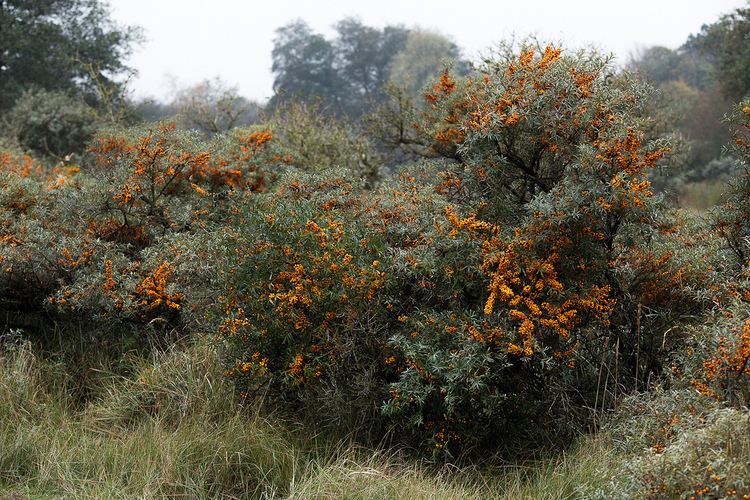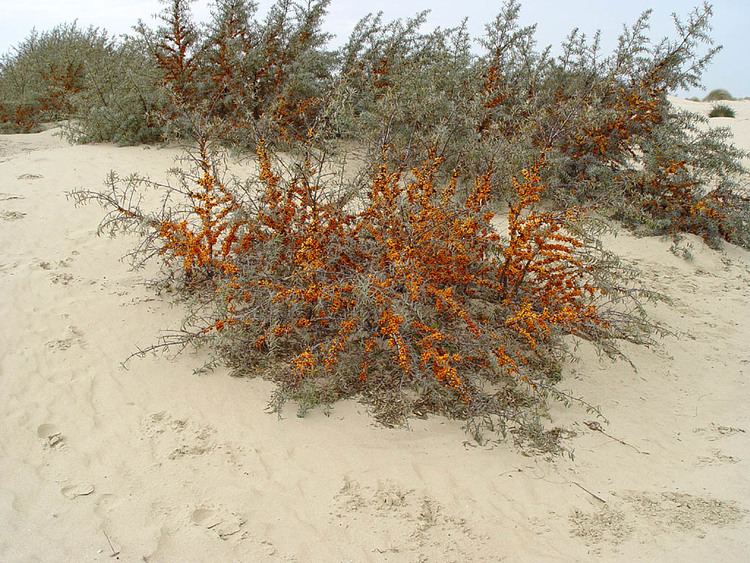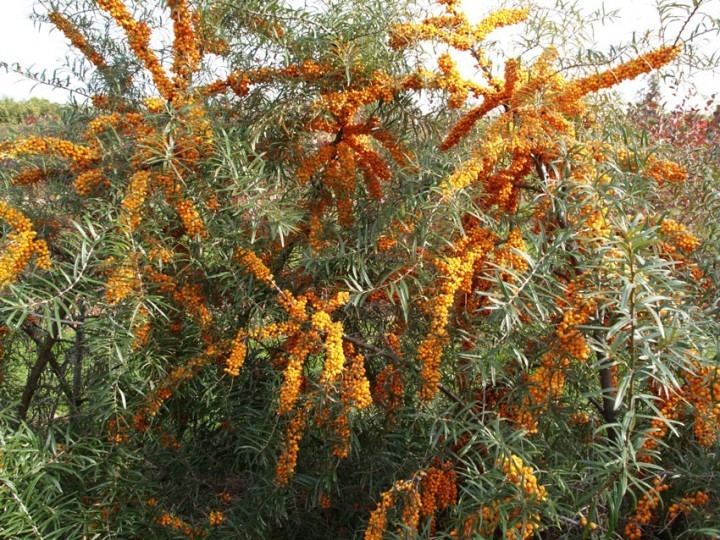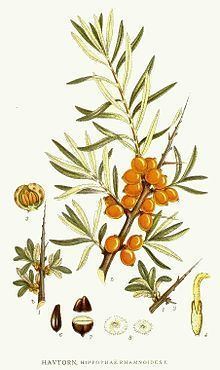Rank Species | Genus Hippophae Higher classification Sea buckthorns | |
 | ||
Similar Sea buckthorns, Strawberry tree, Blackthorn, Chokeberry, Lingonberry | ||
Planting seaberry plant sea buckthorn part 1 hippophae rhamnoides star of altai
Hippophae rhamnoides, also known as common sea buckthorn is a species of flowering plant in the family Elaeagnaceae, native to the cold-temperate regions of Europe and Asia. It is a spiny deciduous shrub. The plant is used in the food and cosmetic industry, in traditional medicine, as animal fodder and for ecological purposes.
Contents
- Planting seaberry plant sea buckthorn part 1 hippophae rhamnoides star of altai
- Hippophae rhamnoides common sea buckthorn
- Description and biology
- Taxonomy
- Distribution
- Use
- Food and beverages
- Medical and pharmacological uses
- Use as livestock fodder
- Ecological uses
- Soil and climate requirements
- Planting
- Pruning
- Propagation
- Breeding
- Harvesting and challenges in mechanization
- Symbionts
- Diseases and insect pests
- Wilt disease
- Pests
- Weed control
- References

Hippophae rhamnoides common sea buckthorn
Description and biology

H. rhamnoides is a deciduous and hardy shrub that can grow between 2 and 4 m high (between 7 and 13 ft). It has a rough, brown or black bark and a thick, grayish-green crown. The leaves are alternate, narrow and lanceolate, with silvery-green upper faces. It is dioecious, meaning that the male and female flowers grow on different shrubs. The sex of seedlings can only be determined at the first flowering, which mostly occurs after three years. The male inflorescence is built up of four to six apetalous flowers, while the female inflorescence normally consists of only one apetalous flower and contains one ovary and one ovule. Fertilization occurs solely via wind pollination, which is why male plants need to be planted near the female plants to allow for fertilization and fruit production.

The oval or lightly roundish fruits grow in compact grapes varying from pale yellow to dark orange. Individual fruits weigh between 270 and 480 mg and contain high amounts of vitamin C, vitamin E, carotenoids, flavonoids and health-beneficial fatty acids, as well as higher amounts of vitamin B12 than other fruits.

The plants have a very developed and extensive root system, and the roots live in symbiosis with nitrogen-fixing Frankia bacteria. The roots also transform insoluble organic and mineral matters from the soil into more soluble states. Vegetative reproduction of the plants occurs rapidly via root suckers.
Taxonomy
H. rhamnoides is situated in the family Elaeagnaceae, in the order Rosales.
H. rhamnoides is divided into eight subspecies: ssp. carpatica, caucasia, fluviatilis, mongolica, rhamnoides, sinensis, turkestanica and yunnanensis. These subspecies vary in size, shape, number of main lateral veins in the leaves and quantity and color of stellate hairs. They also have different areas of distribution and specific utilizations.
"Sea buckthorn" is a term used for all species of the genus Hippophae. The genus name Hippophae originates from the Greek words hippo = "horse" and phaos = "to shine" and is due to the ancient Greek use of sea buckthorn leaves as horse fodder to make their coats shine more. The species name rhamnoides means "resembling the Rhamnus", referring to the buckthorn plant.
Distribution
H. rhamnoides is native to the cold-temperate regions of Europe and Asia, between 27 and 69EN latitude and 7EW and 122EE longitude. These regions include the Baltic Coasts of Finland, Poland and Germany, the Gulf of Bothnia in Sweden, as well as coastal areas of the United Kingdom. In Asia, H. rhamnoides can be found in the northern regions of China, throughout most of the Himalayan region, including India, Nepal and Bhutan, as well as in the northern regions of Pakistan and Afghanistan. It is found in a variety of locations: on hills and hillsides, valleys, riverbeds, along coastal regions, on islands, in small isolated or continuous pure stands, but also in mixed stands with other shrub and tree species. H. rhamnoides has also recently been planted in countries such as Canada, USA, Bolivia, Chile, South-Korea and Japan.
The current total acreage of H. rhamnoides is about 3.0 million ha worldwide. This number includes both wild and cultivated plants. Of these, approximately 2.5 million ha are situated in China (1.0 million ha of wild plants and 1.5 million ha in plantations), 20 000 ha in Mongolia, 12 000 ha in India and 3 000 ha in Pakistan. This makes China the largest agricultural producer of H. rhamnoides. Approximately 10 000 acres of the plant are planted in China each year for berry production as well as eco-environmental improvement. As of 2003, approximately 100 km of field shelterbelts were planted in Canada each year, and over 250 000 mature fruit-producing plants were grown on the Canadian prariries with an estimated annual fruit supply of 750 000 kg. Other countries that grow H. rhamnoides as an agricultural plant include for example Germany and France.
Use
H. rhamnoides is a very versatile plant and the fruits as well as the leaves can be used. The fruits are processed and then used in the food industry, in traditional medicine, as part of drugs or in the cosmetic industry. The leaves can be used as feed, particularly for ruminants. Because of its tolerance against strongly eroded, nutrient poor and sometime salty soils, the plant is also used for land reclamation or as shelterbelt.
Food and beverages
In general, all parts of the H. rhamnoides contain several bioactive compounds that can have positive health effects for humans as well as livestock. Particularly the fruit contain high vitamin C amounts, which exceed the ones of lemons and oranges. The H. rhamnoides fruits are processed in the food industry to different products. Usually, the berries are first washed and then pressed, resulting in press-cake and juice. The fruit press cake can be used to gain oil, natural food colour pigments (yellow/orange) or jam while the juice is further processed and then packaged as final juice product. Even in countries where there is no H. rhamnoides production, at least a few products can be found. It is usually possible to buy H. rhamnoides jam or fruit concentrate, fruit juices and some cosmetics, such as hand cream, shampoo or massage oils. In southern France for example, H. rhamnoides is commonly sold as fruit juice or as an ingredient in non-alcoholic and alcoholic mixed beverages. Typical liquor produced at the same latitudes in Italy, Tuscany, is the officinal Tuscan liquor – Spinello.
The leaves of the shrub can be air dried, eventually grinded and used for tea. The drying and milling process do not cause considerable losses of bioactive substances and thus confer a healthy composition to the infusion.
Medical and pharmacological uses
H. rhamnoides is widely used as traditional medicinal plant all over the globe and particularly in Russia and North-East Asia (e.g. P.R. China, Mongolia and Tajikistan). The leaves are used as herbal medicine to alleviate cough and fever, pain, diarrhea and general gastrointestinal disorders as well as to cure dermatologic disorders. Similarly, the fruit juice and oils can be used in the treatment of liver disease, gastrointestinal disorders, chronic wounds or other dermatological disorders. H. rhamnoides fruits have also been used in the traditional Austrian medicine internally as tea, juice, or syrup for treatment of infections, colds, and flu. H. rhamnoides is also used in modern medicine to cure or alleviate similar diseases or disturbances as in traditional medicine. Various pharmacological activities such as cytoprotective, anti-stress, immunomodulatory, hepatoprotective, radioprotective, anti-atherogenic, anti-tumor, anti-microbial anti-ulcerogenic and tissue regeneration have been reported.
Use as livestock fodder
There is a high potential for H. rhamnoides use for the feeding of livestock. The shrub is usually pruned and the leaves from the cut branches can be eaten by the animals and supply them with proteins and valuable chemicals. Also the waste from the H. rhamnoides fruit processing can be used as animal feed. H. rhamnoides is for example used in the cold and arid regions of northern India as poultry feeding, where leaves, seeds and fruit residues are fed to the poultry and result in a higher egg weight rate. In other countries, horses and camels are fed with H. rhamnoides leaves and fruit residues.
Ecological uses
The H. rhamnoides plant is particularly drought and salt tolerant and can thus be successfully used for land reclamation, against further soil erosion, as shelterbelt or in agroforestry. These characteristics are mainly due to the deep root system that the plant develops. For example, in eastern China, new agroforestry systems have been developed to reclaim land with high salinity contents and H. rhamnoides is included in the system as shelterbelt, providing a habitat to different birds and small mammals.
Soil and climate requirements
In nature H. rhamnoides is found growing profusely on a wide range of soil types, but does better in soils with a light physical structure, rich in nutrient compounds and with a pH near neutral (pH 6.5–7.5). Best growth occurs in deep, well drained, sandy loam with ample organic matter. Very light, sandy soils have low water carrying capacity and are also low in nutrient mineral elements; so without the previous addition of organic matter, are not appropriate. Similarly inappropriate are clayey soils, with high density and water retention characteristics. H. rhamnoides is considered drought resistant but it is a moisture sensitive plant especially in the spring when plants are flowering and young fruits are beginning to develop. Planting in arid or semiarid areas is possible, if water is supplied for establishment. It can bear fruits at altitudes up to 2000 m above sea level. The plant can withstand temperatures from −43 °C to + 40 °C Vegetation begins at average daily air temperatures of 5 to 7 °C. It flowers at temperatures 10 to 15 °C and requires total effective temperatures, spring to harvest time, of 14.5 °C to 17.5 °C, depending on latitude, elevation and species. Frost hardiness is the highest in deep dormancy in November and December. During this period, negative temperatures of −50 °C may be tolerated. Whereas in the post-dormant period in January to March, the critical temperature drops in air temperature for the male to −30 °C to −35 °C and for the female, −40 °C to -45 °C. H. rhamnoides can only be grown in well-lit, unshaded areas. Starting from its very earliest stage of development, it can not tolerate shade. As for fertilization, phosphorus is indispensable for the normal life process of the nodules on the roots. The plant requires little nitrogen, due to its ability to fix nitrogen.
Planting
H. rhamnoides needs a period of 4 to 5 years from the appearance of the first shoots from the seeds to the beginning of fruit and peaks at the 7–8th year of plant life, remaining productive for 30 years with intermittent pruning. Spring is the best time for planting H. rhamnoides. An orchard planting can yield 10 tonnes of berries per hectare. A number of seeds per planting site is recommended at spacing of 1 m within the row and 4 m between the rows, south-east sloping terrain is recommended to facilitate the maximum sunlight exposure and rows should be oriented in a north– south direction to provide maximum light.
Pruning
The purpose of pruning H. rhamnoides is to train branches, promote growth and facilitate harvesting. Moderate pruning will increase the yield and fruiting life of the plants. The crown should be pruned to remove overlapping branches, and long branches should be cut to encourage development of lateral shoots. Mature fruiting plants should be pruned to allow more light penetration. Pruning is also recommended to eliminate thorns on the mature wood to facilitate harvesting. Pruning should be started the year trees have been planted, late winter pruning is best time.
Propagation
Seed propagation is not commonly used in orchards because the species is dioecious, therefore the sex cannot be determined in the seed, or prior to 3 to 4 years of growth. And male plants must be replaced. If seedlings of unknown sex are planted, it may result in an uneven distribution of male and female plants. To avoid this problem, excessive male plants are replaced with female plants, or vegetative propagation from mature plants of known sex is done. With vegetative propagation, the cuttings will bear fruit 1 to 2 years earlier than seed propagated trees and the genetics and sex are known from the mother plant. Sea buckthorn can be propagated using either hardwood or softwood cuttings, root cuttings, layering and suckers. Cross-pollination is by wind action only. The ratio and distance of male to female plants is important, as the number of female trees in each planting directly affects the total yield. Recommendations for male and female ratio vary from 6 to 12%, while the distance within which the female plant can be pollinated is about 100m. It has been shown that as the distance from the female plant to the male plant (polliniser) increases (64m), the yield of the female plant decreases.
Breeding
The large morphological diversity is a good indication for opportunities in selection of desired characteristics for a given region. Mass selection is still practiced in many areas, although it is gradually replaced by hybridization and polyploidy breeding. The most important characteristics that need improvement are: yield, fruit size, winter hardness, thornlessness, fruit and pollen quality and early maturity, long pedicel (to facilitate mechanical harvest) and nitrogen fixing ability.
Harvesting and challenges in mechanization
The fruits ripen in the fall and frequently cling on the shrub until the following March/April. Estimate of orchard planting with 4,000 trees per hectare and a 1:6–8 male and female ratio, should yield approximately 10 tonnes. Good plants will produce up to 7 kg annually. In Asia the fruits are harvested per hand, this process requires about 1500 person-hours/ha. Fruit harvest is the most time consuming operation in growing H. rhamnoides. The relatively small fruit size, short pedicel, force required to pull off each fruit, the density of fruit on the branch, and the thorniness of the plant, are the disadvantages during harvesting.
Difficulties in harvesting are the major barriers of orchard production and development the plants potential as a cash-crop. Harvesting the fruit is problematic because the fruit does not easily release from the stem. Different mechanical harvester have been developed, such as shaking, vacuum and quick freezing, but most have disadvantages of fruit and bark damage and low efficient. Except when frozen on the shrub, fresh fruit mechanical harvesting is still in the development stage. This is mainly due to the difficulty in separating the stem(pedicel) from the berry (pericarp). The mechanical harvesting method usually eliminates the necessity for maintenance pruning, leaving a hedge that has been uniformly cut back. A trunk clamp-on vibrator harvester may be used when the fruit is frozen on the shrub, with this method leave and wood contamination is high and an additional step of berry cleaning is necessary.
Symbionts
H. rhamnoides plants that are 1–2 years old develop root nodules containing actinobacteria of the genus Frankia, which are capable of fixing nitrogen. As a result of this relationship, the soils in stands of H. rhamnoides are enriched in nitrogen. The nitrogen-fixing activity of the symbiotic bacteria is not constant, but depends on external factors such as the climate or whether additional nitrogen fertilization occurred.
Diseases and insect pests
Both in Asia and in Europe, sea buckthorn losses occur notably due to environmental stress, wilt disease and insect pests. It is estimated that more than 60 000 ha of natural and planted sea buckthorn stands have died in China since the year 2000 due to these three factors, and approximately 5 000 ha perish each year.
Wilt disease
Wilt disease is a combination of fungal diseases that is sometimes also called "dried-shrink disease", "shrivelled disease", "dry rot" or "dry atrophy". In China, it causes fruit yield losses of 30–40% and annual losses of mature plantations of 4 000 ha. Several pathogens have been described as causing the sickness in sea buckthorn:
Methods to control the disease include removing and burning infected branches, not replanting H. rhamnoides at the same site for 3–5 years, and avoiding to make cuttings from infected plants. Antagonistic fungi like Trichoderma sp. or Penicillium sp. can be used to combat wilt disease in plants infected by Plowrightia hippophaes. Additionally, four strains of Cladothrix actinomyces were found to be usable as antagonistic fungi in H. rhamnoides plants infected by Fusarium sporotrichioides. Cultivars of H. rhamnoides that were relatively resistant to wilt disease have also been identified.
Pests
H. rhamnoides is affected by several insect pests, of which green aphids (Capitophorus hippophaes) are one of the most damaging. They are usually found in the new growth on shoot tips where they stunt growth and cause yellowing of the leaves. This is then followed by shrinking of the leaves along their central vain, after which they drop prematurely. Another serious pest is the seabuckthorn fruit fly (Rhagoletis batava), whose larvae feed on the fruit flesh, rendering the fruits unsuitable for use. H. rhamnoides is also affected by the gall tick (Vasates spp.), which causes gall formation on the leaves and thereby leads to deformation of the leaf surface. Both the leaf roller (Archips rosana) and the gypsy moth (Lymantria dispar) chew on H. rhamnoides leaves. The leaf roller occurs from May to July, while the gypsy moth occurs later in the summer. Further insect pests include the commashaped scale (Chionaspis salicis), which sucks sap from the bark and can cause important damage by leading to the death of the plant, and the larvae of the sea buckthorn moth (Gelechia hippophaella), which penetrate into fresh buds and feed on them. Thrips, and occasionally earwigs have also been observed as affecting H. rhamnoides.
Insecticides such as gammaxene and dylox are used to control insect pests in the soil, and insecticide soap can be employed against green aphid infestations
H. rhamnoides is also involved in interactions with various animals (birds, rodents, deer, livestock) that can lead to damage in plantations.
Weed control
Weed control is important, especially during the early growth stages of H. rhamnoides, since it grows slower than weeds due to its less vigorous root system. Weeds should be removed before planting by preparing the land adequately, and they should subsequently be controlled during the first four to five years, until the shrubs are high enough to shade out the weeds. Weed control is done both mechanically and manually. Weeding should however not be too deep so as not to damage the root system of H. rhamnoides.
As of 2003, no herbicides were registered for use in orchards of H. rhamnoides.
